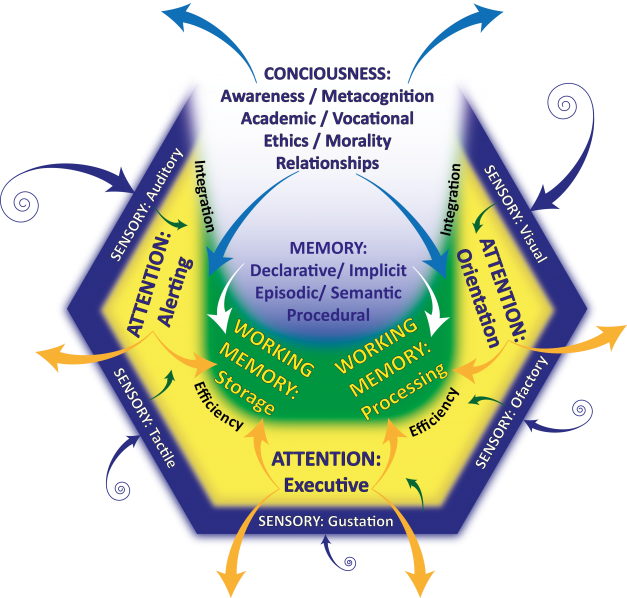Introduction to the CFDI Therapeutic Model
The CFD Institute promotes cognitive function development therapy based on a unified model of basic or primary cognitive functions upon which all other cognitive functions and higher-order processes depend. From this perspective, all therapeutic [[[Category:Procedures | procedures]] will necessarily exercise the primary functions. However, those activities which target, stimulate, develop, and integrate these primary functions to have the greatest efficiency in terms of achieving therapeutic goals, and are understood as foundational to CFDT’s long-lasting, far-reaching, transferable results.
The three primary cognitive functions of the therapeutic model are attention, working memory, and long term memory. Within the therapeutic model, attention and working memory are inextricably linked, being composed of overlapping web-like networks which utilize many of the same neural resources and structures. [1] [2] Empirical research indicates that both attention and working memory rely on the various sensory cortexes, both for stimulus input and for short term information storage. [3] [4] [5] [6] Thus, on the outermost portion of the therapeutic model we include representation of the various sensory cortexes. These are to be understood as being separate structures at various locations throughout the brain, but as being included within the attention / working memory neural network.
Attention and working memory are conceived of as being a single, transcranial “neural-web” of inextricably interconnected, mutually dependent subnetworks, within which there is the possibility of separate, albeit coupled, networks centered around each of the sensory inputs. Of therapeutic importance is that attention and working memory function in unison, and require the efficient coordination / integration of multiple discrete brain structures. A significant portion of therapeutic procedures will, therefore, be designed to target and develop the capacity, integration, and efficiency of attention and working memory.
Working memory is also strongly related to and bi-directionally dependent upon long term memory. That is, efficient processing of information selected as relevant by the attention system depends on working memory’s ability to receive copies of related information from long term memory. For example, a child only recently learning addition will struggle to quickly process requests for sums, and will most likely not be able to correctly give the product two numbers without direct guidance (even if the child is capable of the mathematical computations). Thus, therapeutic procedures are also developed to enhance the encoding and recall of information to and from long term memory.
Stimulating and developing the three primary cognitive functions will be a stable of most, if not all therapeutic sessions. Depending on the therapeutic plan, however, additional time each week or each session can be devoted to working with the client on secondary or tertiary cognitive functions, or even on higher-level processes. Development of procedures to address these functions and procedures will be dependent upon client abilities and outcome goals, and will thus be developed on a case-by-case basis.
Citations
- ^ Moore, Davis R., et. al. (November 26, 2015). “The Persistent Influence of Concussion on Attention, Executive Control, and Neuroelectructric Function in Preadolescent Children.” International Journal of Psychophysiology. vol. 99, pp 85-95. Article Link.
- ^ Fougnie, Daryl (2008). “Chapter 1: The Relationship between Attention and Working Memory.” Conference Proceedings Article Link.
- ^ Taylor, Joathon G. (2008). “On the Relationship between Attention and Consciousness.” Conference Proceedings. Article Link.
- ^ Sarter, Marting, et. al. (2001). “Cognitive Neuroscience of Sustained Attenion: Where top-down meets bottom-up.” Brain Research Reviews . vol. 35, pp 146-160. Article Link.
- ^ Barton, Brian and Alyssa A Brewer (June 12, 2019). “Attention and Working Memory in Human Auditory Cortex.” IntechOpen. Chapter Link.
- ^ Moss, Andrew, et. al. (2019). “Olfactory Working Memory: Exploring the differences in n-back memory for high and low verbalizable oderants.” Memory. Article Link.
